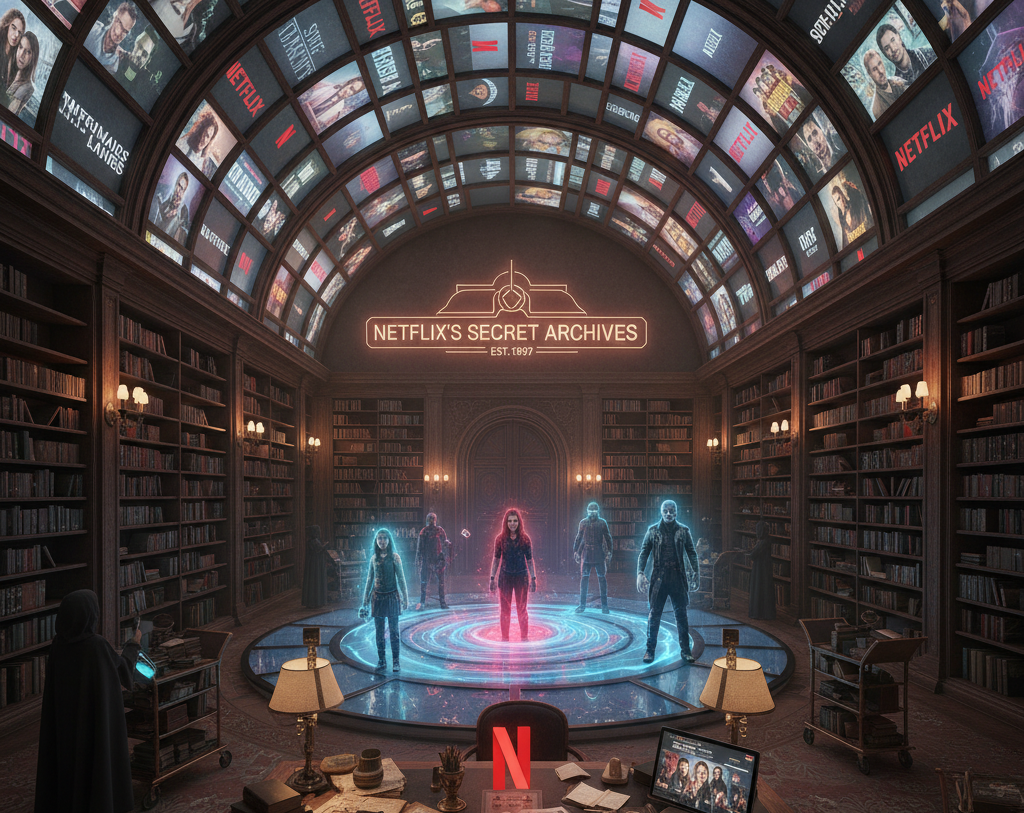The Truth About Netflix’s Secret Library: Why India Sees Less Content

Introduction: The Illusion of Global Access
The Promise vs. the Reality
You’d think a company that says “watch anywhere” offers the same catalogue everywhere. In practice, Netflix is global in reach but local in content. Log in from Mumbai and your homepage may look very different from someone in New York or Tokyo — and that difference is not an accident, it’s a byproduct of how media rights are bought and sold.
A Viral Example: When a Hit Title Is Missing
Remember when a buzzed-about Oscar winner or a trending American series lights up social feeds — and fans in India discover they can’t watch it immediately? Those viral moments highlight the frustration: the show exists, Netflix streams it in one country, but legally can’t show it in another yet. That sting of “you see it, I don’t” is exactly what drives people to dig for explanations.
Exposing the “Secret Library”
The Disparity in Numbers (What the data shows)
Catalogs vary dramatically by country. Historically, the U.S. catalog has had far more unique titles than many international markets; when Netflix first expanded internationally there were stark differences in available titles between the U.S. and other countries — a pattern that still exists in nuanced form today. Independent catalog trackers and databases show region-by-region differences, which is why communities maintain global catalog lists and comparison tools.
The Catalogue Gap: More Than Just Bollywood
It’s not only the absence of certain U.S. TV series or Hollywood classics — sometimes entire documentary libraries, niche genres, or decades-old favorites are licensed away or restricted. For Indian viewers, the loss isn’t simply foreign titles; it’s the depth of choice across genres that disappears when regional rights are split.
Why the Walls Exist: Licensing, Deals, and Geography
The Legal Battlefield: Rights Sold Territory-by-Territory
Here’s the core truth: content rights are typically sold territory-by-territory. Studios, distributors, and rights holders often parcel their catalogs into regional deals to maximize revenue and control windows. That means Netflix doesn’t automatically “own” worldwide streaming permission for most licensed titles — it negotiates for each territory. Think of it like buying a movie ticket that’s valid only in the theater where you bought it.
Movie-ticket analogy: rights tied to a place
When a studio sells streaming rights for a show to a broadcaster in India, Netflix can’t legally stream that show in India — even if it hosts the same show elsewhere. That’s why a series might be on Netflix UK but absent on Netflix India.
Competing Local Deals: Who Buys What First
Regional competitors (local OTT platforms, TV networks, or even other global streamers) may lock exclusives. If a studio sells Indian streaming rights to Platform X for a five-year window, Netflix must wait — or pony up even more money — to obtain those same rights.
The Regulatory and Censorship Pressure Valve
One thing beyond deals is a fact and that is local rules matter. Content may be withdrawn, edited, or blocked in certain countries. This is mainly because of regulation or legal challenges. This adds another layer even when rights exist. The compliance and censorship demands can restrict availability in a market like India.
The Business Logic: Economics of Global Rights
Price Discrimination & Local Market Value
What does it mean when you hear that studios price geographically? This means a big blockbuster may command higher fees in markets that can pay more. For Netflix, buying global rights for every title would be astronomically expensive and often unnecessary where expected viewership is lower. So Netflix balances by buy global hits, produce originals, and license selectively.
Originals vs. Licensed Content: The long-term play
That’s why you see Netflix pouring money into originals — controlling IP avoids territorial headaches. Originals are a global asset Netflix can show everywhere (subject to local censorship), whereas licensed titles remain hostage to market-by-market deals.
How the User Experiences the Gap
Lost classics and missing series (examples)
Users notice when beloved shows aren’t available, or when streaming platforms hold staggered windows. It is often seen in forums and social feeds brim with lists of “shows not on Netflix India”. This is a real-time catalog of disappointment.
Delayed launches and staggered releases
Sometimes titles arrive months later in India. This delay kills buzz. Studios might prioritize theatrical or TV windows, or stick to staggered digital rollouts to squeeze more revenue from each region.
Data & Tools That Reveal the Difference
Catalog-tracking sites and what they show
Sites and databases (and community-built trackers) index what’s available per country. They’re valuable because Netflix doesn’t publish a clean, region-by-region public list — trackers fill the transparency gap. These tools show how titles are exclusive to specific countries or missing entirely elsewhere.
Why numbers fluctuate week to week
Titles come and go as licenses expire or new deals are struck. That’s why your favourite title might disappear suddenly: the contract ended, and the rights holder chose not to renew for that territory.
The Social Side: Frustration, Tweets, and Culture
Why it feels unfair (and why people rage online)
Perception matters. Streaming marketed as “global” sets an expectation. When reality diverges, users feel cheated — especially when social media is full of spoilers and clips from the exact content they can’t access locally.
The churn effect: subscribers, complaints, and switching
Content disparity influences churn. Some users switch services to chase exclusives; others use workarounds. Platforms know this — it’s why exclusives are such valuable currency in their competitive strategy.
The User’s Power: Bridging the Digital Divide
Realistic actions: wait, petition, or negotiate expectations
Consumers have options that stay within legal and public channels: petition platforms to bring titles sooner, make local demand visible via social channels, or vote with subscriptions toward services that deliver the content you want.
The technical note: a single widely known workaround
Tools exist for dedicated streamers who are eager to access an international library immediately,. Specifically, the use of a VPN for accessing global content is widely recognized as the primary method to switch your virtual location and bypass geographical restrictions, effectively “unlocking” the content meant for other regions. (Note: platforms may actively block or limit access when they detect this, and using a VPN to access region-locked content enters a gray area of terms of service and, in some jurisdictions, legal risk.)
What Can Be Done? Policy, Platforms, and Pressure
Industry-level fixes: pooled rights, windowing reform
Long-term change would come from structural shifts: studios experimenting with global windows, pooled licensing agreements, or new business models that make global rights more affordable and less fragmented.
Consumer-level pressure: collective action and platform choice
Consumers can push change by making demand visible (organized requests, social campaigns) and by choosing platforms whose catalog strategies align with their expectations. The market reacts to sustained user pressure.
Conclusion: The Content Gap Is Legal — Not Personal
The reason India sees less of some Netflix content isn’t because Netflix is deliberately stingy — it’s because the modern media economy sells rights regionally, creates exclusive deals, and navigates local rules. That creates a ‘secret library’ effect: the global brand is the same, but the content behind the door depends on contracts, money, and law. Knowing that helps — and whether you wait, petition, switch services, or explore technical workarounds, you’ll do so armed with the real reason the walls are there.
Frequently Asked Questions
Q1: Is Netflix hiding content on purpose from India?
No — the gap is mainly due to territorial licensing, exclusive deals, and local regulations, not arbitrary hiding by Netflix.
Q2: Will Netflix ever make all libraries identical worldwide?
Unlikely soon. Global equalization would require studios to sell global rights more often or for Netflix to pay far higher fees — both costly and legally complex.
Q3: Are catalog-tracking sites accurate for checking availability?
They’re useful indicators. Third-party trackers and community databases compile regional catalogs and are the best practical way to compare libraries, though they may lag behind real-time licensing changes.
Q4: Does producing more Netflix Originals in India solve the problem?
Partially. Originals bypass external licensing, so they can be shown globally, but originals don’t replace the demand for licensed classics and varied catalogs.
Q5: Is using a VPN a safe, legal fix?
A VPN is a widely known technical workaround to appear as if you’re in another country, and many viewers use it for accessing different catalogs. However, streaming platforms may block VPNs, and using one to bypass geo-restrictions can violate terms of service and may carry legal or account risks depending on local laws and provider policies.






